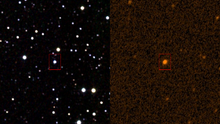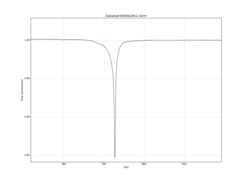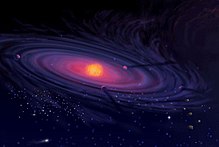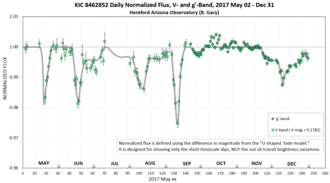KIC 8462852
|
Star KIC 8462852 |
|||||
|---|---|---|---|---|---|

|
|||||
| AladinLite | |||||
|
Observation dates equinox : J2000.0 , epoch : J2000.0 |
|||||
| Constellation | swan | ||||
| Right ascension | 20 h 06 m 15.45 s | ||||
| declination | + 44 ° 27 ′ 24.8 ″ | ||||
| Apparent brightness | 12.01 ± 0.20 mag | ||||
| Typing | |||||
| B − V color index | 0.81 | ||||
| Spectral class | F3 V | ||||
| Astrometry | |||||
| parallax | 2.219 ± 0.024 mas | ||||
| distance | 1,470 ly 450 pc |
||||
| Proper movement | |||||
| Rec. Share: | −10.42 ± 0.04 mas / a | ||||
| Dec. portion: | −10.29 ± 0.04 mas / a | ||||
| Physical Properties | |||||
| Dimensions | 1.43 M ☉ | ||||
| radius | 1.58 R ☉ | ||||
| Luminosity |
3.0 L ☉ |
||||
| Effective temperature | 6000-7350 K | ||||
| Rotation time | 0.8797 days | ||||
| Age | > 150 mill. A | ||||
|
Other names and catalog entries |
|||||
|
|||||
KIC 8462852 , also Tabbys Star (English Tabby's Star , also Boyajian's Star , after Tabetha S. Boyajian , the main author of the publication from September 2015), is a main sequence star of the spectral class F (such as the Pole Star ) in the constellation Swan , 451 (± 5) parsecs (1470 ly ) from Earth. The name refers to the Kepler Input Catalog , or KIC for short . Other names of the star are TYC 3162-665-1 ( Tycho catalog ) and 2MASS J20061546 + 4427248 ( Two Micron All Sky Survey ).
parameter
KIC 8462852 is 1.58 times the diameter and 1.43 times the mass of the sun . The gravitation is log g = 4.0 ± 0.2. Due to the larger diameter and the higher surface temperature, the star's visual luminosity is 5 times that of the sun. The apparent magnitude is 12 mag. KIC 8462852 rotates on itself within 21.12 hours.
The habitable zone is at KIC 8462852 at a greater distance from the star than in our solar system. Age is decisive for the condition of the star's environment. In particular, it depends on the age whether a planetary system has already formed. It is assumed that KIC 8462852 has just reached the main sequence. This takes into account and with regard to its rotational speed it can be assumed that the star is older than 150 million years.
Special features of KIC 8462852
The space-based Kepler telescope has identified numerous extrasolar planets that periodically pass in front of their central stars and therefore also cause periodic drops in brightness of the star (usually well below 1%). As part of the Planet Hunter project , short, non-periodic brightness reductions of up to 22% were noticed in KIC 8462852 . A search for comparable stars in the Kepler databases (around 100,000 stars) did not yield any hits for comparable stars.

The Kepler telescope examined the star around 4 years before it failed due to a defect. The first strong reduction in brightness (dip ) took place on March 5, 2011 (day 792 of the Kepler observation). The brightness was reduced by around 16% within one day for just one day. After that, the brightness was around 100% again.
The second outstanding decrease in brightness took place on February 28, 2013 (day 1,519 of the Kepler examination). The star's brightness was reduced by 1.5% for around three days around 10 days before the greatest reduction in brightness. After that, the brightness increased a bit. Then the strongest slump followed with around 22% for about two days. In contrast to the first strong dip around 2 years earlier, a dip for around 10 days followed around 20 days later (strongest value −3% on one day) and after a further 37 days a dip over 10 days (strongest value −8% in one day) ). In comparison, the brightness only slowly returned to 100%. The interval between the two strongest dips measured is 728 days.
Explanatory approaches
Since the discovery of the aperiodic light curve, various explanatory hypotheses have been published. Almost all of them are based on the basic assumption that the spectral class does not match a variable star . However, none of the following attempts at explanation have so far provided a complete description of the light curve.
Dust rings
Based on data from the Swift gamma-ray telescope , the Spitzer space telescope and the Belgian observatory AstroLAB IRIS , microscopically fine dust, irregularly distributed over circumstellar rings, is said to cause the attenuation of the light. It is based on the observation that the star's infrared and ultraviolet radiation are weakened to different degrees. Long-lasting drops in brightness, as observed in 2017, could also be explained in this way.
Comet fragments
An accumulation of comets and comet fragments (similar to the solar Oort cloud ) was also considered as a possible cause of the drops in intensity. The existence of such an accumulation, which would be so close to the material that it could explain the attenuations observed, is considered rather improbable.
Accretion disk
Assuming that the star is much younger than assumed based on its spectral class , then the accretion disk or a protoplanetary disk that was present during star formation could explain the observations. However , studies carried out at the IRTF did not reveal any central dust disc in the system. In addition, a protoplanetary disk is exhausted within a few million years.
Fragments of a planetary collision
This hypothesis, too, is fundamentally refuted by the above investigation. Apart from the rather low probability of such a collision , spectral analyzes with the Spitzer and WISE telescopes did not find any evidence of hot or warm fragments, i.e. H. for a recent collision.
Collisions between asteroids or comets, which could renew a dust cloud or a dust ring over a longer period of time, would be more likely than a one-time collision of two planets.
Interplanetary dust
If there are indications of the lack of a circumstellar dust disk as well as indications of the occurrence of energy-dispersive absorption or scattering by particles on the order of 1 μm, the possibility of interstellar dust would still exist. However, there is no positive evidence to date. In addition, the particle size of interstellar dust is typically well below 1 μm.
Planet annihilation by the star
An interesting hypothesis was suggested by Metzger et al. set up, which propagated a planet that spiraled closer to its star until it was swallowed up by it as the cause. The event should have occurred between 10 1 and 10 4 years in the past (depending on the mass of the planet) and the weakening would then be caused by the remaining debris of the planet or its moons. The energy resulting from the collision would have made the star shine brightly and its luminosity would now slowly fall back to its initial value.
Ring planet with Trojans
The fluctuations in brightness can also be traced back to the passage of a planet which is surrounded by a huge (possibly interrupted) ring of dust and which is also accompanied by many Trojan rock chunks that move at a fixed distance from the planet in the same orbit around the star, but around it Rush ahead or run 60 degrees ahead. You are at the Lagrange points L4 and L5, where the forces of attraction of planet and star are balanced in such a way that more and more fragments can accumulate. The weak fluctuations in brightness in 2009 would have been caused by remnants of Trojans hurrying ahead. Then the starlight weakened again through the passage of the hypothetical ring planet. In the spring of 2013, Trojans running behind caused the rapid changes in brightness. From February 2021, Trojans running ahead would have to darken the star again.
More recent observations from 2017 and 2018, however, showed the weakening phases to occur very irregularly over time, which tends to contradict this hypothesis.
Intrinsic fluctuations in luminosity
Changes in the absolute brightness of a star as an example of a dynamic system could occur in the vicinity of a phase transition in a quasi “self-organized” manner if the fluctuations correspond to universally valid “avalanche statistics” . Three other stars in the Kepler Input catalog apparently show similar fluctuations in brightness and have been shown to have magnetic activity. This is said to have also been observed at KIC 8462852. It has not yet been proven whether this behavior corresponds to that of BY-Draconis stars .
Artificial structures
Speculations about an unnatural cause of the phenomenon were initially among the more commonly proposed hypotheses, but did not stand up to more serious investigation. Covering by a Dyson sphere that is being created is not considered, since this would be accompanied by an additional infrared component that is not observed.
In October 2015, the SETI institute began to observe KIC 8462852 with ATA for an initial period of 15 days; the radio telescope in Green-Bank and the Very Large Array were also proposed for future investigations. First radio astronomical investigations of the star did not show any abnormal radio signals. The search in other wavelength ranges, such as in the gamma range , or the search for laser radiation were also unsuccessful.
Long-term decrease in brightness?
A publication in January 2016 emphasized that the star's brightness has been decreasing since 1890. Therefore, the cause of comets is implausible. An analysis of long-term brightness observations carried out up to the end of 2016, published in October 2017, confirms the long-term decrease in brightness over the period of the Kepler observations and the subsequent time without committing to an explanation. An analysis of 1,232 Harvard University photographic plates, on which the star was taken between 1890 and 1989, showed that the star was constantly darkening for over a century, the analysis is controversial.
Observations 2017
Future observations with the Las Cumbres Observatory Global Telescope Network, which started in May 2017, were funded via crowdfunding . Up to December 2017, five phases of attenuation were observed, which lasted between a few days and several weeks and were confirmed by numerous other observatories. The drops in brightness were between 1.5 and 2.5%. In October 2017, the star's brightness was above the "100% line" for days. The cause is so far unknown
Observations 2018
After a brief winter break, observations by KIC 8462852 were resumed on March 6, 2018. On March 16, 2018, the beginning of the next drop in brightness was registered. Up to March 27, attenuations of up to 5% of the initial brightness were registered.
literature
- Kosmos Verlag: Kosmos Himmelsjahr 2019 Sun, moon and stars in the course of the year . 1st edition. Stuttgart 2018, ISBN 978-3-440-15840-1 , pp. 206 ff .
Web links
- Florian Freistetter : The “most mysterious star”: KIC 8462852 and the alleged alien supercivilization Astrodicticum simplex on ScienceBlogs on October 15, 2015
- scinexx : "Alien star" is getting darker again , May 24, 2017 (according to Science Magazine (en) , Phil Plait, May 24, 2017 - NPO)
- KIC 8462852: Where's the Flux? wherestheflux.com, website of Tabetha Boyajian.
Individual evidence
- ↑ a b c d e f TYC 3162-665-1. In: SIMBAD . Center de Données astronomiques de Strasbourg , accessed on September 3, 2018 .
- ↑ a b c d e f Tabetha S. Boyajian u. a .: Planet Hunters X. KIC 8462852 - Where's the Flux? In: Solar and Stellar Astrophysics . January 26, 2016, arxiv : 1509.03622v2 (English, revised version).
- ↑ Jan Bösche: The mystery of "Tabby's star". (No longer available online.) Tagesschau.de, October 22, 2015, archived from the original on November 5, 2015 ; accessed on October 8, 2017 .
- ↑ a b Mike Wall: New Observations Deepen Mystery of “Alien Megastructure” Star. Scientific American , October 5, 2017, accessed October 10, 2017 .
- ↑ a b Huan YA Meng, George Rieke, Franky Dubois, Grant Kennedy, Massimo Marengo, Michael Siegel, Kate Su, Nicolas Trueba, Mark Wyatt, Tabetha Boyajian, CM Lisse, Ludwig Logie, Steve Rau, Sigfried Vanaverbeke: Extinction and the dimming of KIC 8462852 . In: The Astrophysical Journal . tape 847 , no. October 2 , 2017, doi : 10.3847 / 1538-4357 / aa899c , arxiv : 1708.07556 , bibcode : 2017ApJ ... 847..131M .
- ^ A b Elizabeth Landau: Mysterious dimming of Tabby's star may be caused by dust. NASA, October 4, 2017, accessed October 4, 2017 .
- ↑ a b Abby Tabor: The scientific quest to explain Kepler's most enigmatic find. (No longer available online.) NASA, October 4, 2017, formerly in the original ; accessed on October 5, 2017 . ( Page no longer available , search in web archives ) Info: The link was automatically marked as defective. Please check the link according to the instructions and then remove this notice.
- ↑ Tabetha S. Boyajian: The first Post-Kepler brightness dips of KIC 8462852 . January 2, 2018, arxiv : 1801.00732 .
- ^ A b Whitney Clavin, Michele Johnson: Strange star likely swarmed by comets. NASA, November 24, 2015, accessed November 24, 2015 .
- ↑ Paul Gilster: KIC 8462852: The SETI Factor. Centauri Dreams, October 16, 2015, accessed January 12, 2017 .
- ↑ News from the star KIC 8462852: Comets instead of “supercivilization” scienceblogs.de/astrodicticum-simplex
- ↑ UPDATED: Are comet fragments best explanation for mysterious dimming star? astronomynow.com, accessed December 2, 2015.
- ^ A b Jason T. Wright: KIC 8462852: Where's the flux? In: AstroWright. Pennsylvania State University, October 15, 2015, accessed October 16, 2015 .
- ↑ a b Carey Lisse, Michael Sitko, Massimo Marengo: IRTF / SPeX observation of the unusual Kepler light curve system KIC 8462852 . In: The Astrophysical Journal Letters . tape 815 , no. 2 , December 2015, p. L27 , doi : 10.1088 / 2041-8205 / 815/2 / L27 , arxiv : 1512.00121 , bibcode : 2015ApJ ... 815L..27L .
- ↑ heise online: New riddles to KIC 8462852: Mysterious star is getting darker and darker. In: heise online. Retrieved August 6, 2016 .
- ^ Karl E. Haisch Jr., Elizabeth A. Lada, Charles J. Lada: Disk frequencies and lifetimes in young clusters . In: Astrophysics J. Band 553 , April 2001, p. L153 - L156 , doi : 10.1086 / 320685 , arxiv : astro-ph / 0104347 .
- ↑ Massimo Marengo, Alan Hulsebus, Sarah Willis: KIC 8462852 - The Infrared Flux . In: Solar and Stellar Astrophysics . November 24, 2015, arxiv : 1511.07908 (English).
- ↑ Huan YA Meng, Kate YL Su, George H. Rieke, David J. Stevenson, Peter Plavchan, Wiphu Rujopakarn, Carey M. Lisse, Saran Poshyachinda, Daniel E. Reichart: Large impacts around a solar-analog star in the era of terrestrial planet formation . In: Science . tape 345 , no. 6200 , August 29, 2014, p. 1032-1035 , doi : 10.1126 / science.1255153 .
- ↑ Astronomers observe asteroid collision. September 1, 2014, accessed March 29, 2018 .
- ↑ a b Alien Star: But only dust? October 6, 2017. Retrieved October 8, 2017 .
- ^ Brian D. Metzger, Ken J. Shen, Nicolas C. Stone: Secular dimming of KIC 8462852 following its consumption of a planet . In: Monthly Notices of the Royal Astronomical Society . tape 468 , no. 4 , December 2016, p. 4399 - 4407 , doi : 10.1093 / mnras / stx823 , arxiv : 1612.07332 , bibcode : 2017MNRAS.468.4399M .
- ↑ Mario Sucerquia, Jaime A. Alvaro, Vanesa Ramirez, Jorge I. Zuluaga: Anomalous lightcurves of young tilted exorings . September 2, 2017, doi : 10.1093 / mnrasl / slx151 , arxiv : 1708.04600 [astro-ph.EP] (revised version).
- ↑ Fernando J. Ballesteros, Pablo Arnalte-Mur, Alberto Fernandez-Soto, Vicent J. Martinez: KIC 8462852: Will the Trojans return in 2021? May 24, 2017. Retrieved May 23, 2017 .
- ↑ a b c Mohammed A. Sheikh, Richard L. Weaver, Karin A. Dahmen: Avalanche Statistics Identify Intrinsic Stellar Processes near Criticality in KIC 8462852. (PDF) American Physical Society , December 19, 2016, accessed December 22, 2016 . ( doi: 10.1103 / PhysRevLett.117.261101 )
- ^ Steinn Sigurðsson: Viewpoint: New Clues as to Why Boyajian's Star is Dimming. American Physical Society, December 19, 2016, accessed December 22, 2016 .
- ↑ a b Lars Fischer: Extra-Terrestrial Unlikely - 'Tabby's Star' will probably flicker by itself. Spektrum.de, December 21, 2016, accessed on December 22, 2016 .
- ↑ Ross Anderson: The most mysterious star in our galaxy. The Atlantic, October 13, 2015, accessed October 13, 2015 .
- ^ Jason T. Wright, Kimberly MS Cartier, Ming Zhao, Daniel Jontof-Hutter, Eric B. Ford: The Ĝ Search for Extraterrestrial Civilizations with Large Energy Supplies. IV. The Signatures and Information Content of Transiting Megastructures . In: Solar and Stellar Astrophysics . December 14, 2015, arxiv : 1510.04606v2 (English, revised version).
- ↑ Lee Williams: Astronomers may have just found giant megastructures orbiting a star near the milky way. The Independent, October 15, 2015, accessed October 15, 2015 .
- ^ Sarah Kaplan: The strange star that has serious scientists talking about an alien megastructure. Washington Post , October 15, 2015, accessed January 12, 2017 .
- ^ Robert Gast, Patrick Illinger: Enigmatic star awakens alien fantasies. In: Süddeutsche.de . October 15, 2015, accessed October 19, 2015 .
- ↑ Kosmos Verlag: Kosmos Himmelsjahr 2019 Sun, moon and stars in the course of the year . 1st edition. Stuttgart 2018, ISBN 978-3-440-15840-1 , pp. 210 f .
- ↑ Something — we're not sure what — is radically dimming a star's light arstechnica.com
- ^ SETI Institute Undertakes Search for Alien Signal from Kepler Star KIC 8462852 universetoday.com
- ↑ The Curious Case of KIC 8462852 skyandtelescope.com, accessed October 22, 2015.
- ↑ SETI: No Signal Detected from KIC 8462852 centauri-dreams.org
- ↑ SETI confirmed - no extraterrestrials around KIC 8462852 Spektrum.de, accessed on November 9, 2015.
- ↑ AU Abeysekara, et al .: A search for optical flashes letter associated with the SETI target KIC 8462852 . In: The Astrophysical Journal Letters . tape 818 , no. 2 , February 2016, p. L33 , doi : 10.3847 / 2041-8205 / 818/2 / L33 , arxiv : 1602.00987 , bibcode : 2016ApJ ... 818L..33A .
- ↑ Jamie Holder: Latest results from VERITAS : Gamma 2016 . In: AIP Conference proceedings . tape 1792 , no. 1 , September 9, 2016, p. 020013 , doi : 10.1063 / 1.4968898 , arxiv : 1609.02881 , bibcode : 2017AIPC.1792b0013H .
- ↑ Marina Koren: Searching the skies for alien laser beams. The Atlantic, April 17, 2017, accessed June 3, 2017 .
- ^ Nathaniel K. Tellis, Geoffrey W. Marcy: A search for laser emission with megawatt thresholds from 5600 FGKM stars . In: The Astronomical Journal . tape 153 , no. 6 , p. 251 , doi : 10.3847 / 1538-3881 / aa6d12 , arxiv : 1704.02535 , bibcode : 2017AJ .... 153..251T .
- ↑ a b Bradley E. Schaefer: KIC 8462852 Faded at an Average Rate of 0.165 + -0.013 Magnitudes Per Century From 1890 To 1989 . In: Solar and Stellar Astrophysics . January 13, 2016, arxiv : 1601.03256 .
- ↑ Joshua D. Simon, Benjamin J. Shappee, G. Pojmanski, Benjamin T. Montet, CS Kochanek, Jennifer van Saders, TW-S. Holoien, Arne A. Henden: Where Is the Flux Going? The Long-Term Photometric Variability of Boyajian's Star. (PDF) Submitted for publication to AAS Journals, August 26, 2017, accessed on October 8, 2017 .
- ↑ "Alien Star": But only dust? - New observations of the star KIC 8462852 speak against extraterrestrial constructions ". Scinexx , October 8, 2017, accessed on October 8, 2017 .
- ↑ Michael Hippke, Daniel Angerhausen: KIC 8462852 did likely not fade during the last 100 years. January 2016 ( arxiv : 1601.07314v1 )
- ^ Bradley E. Schaefer: A Response to Michael Hippke. January 28, 2016, accessed February 8, 2016 .
- ↑ Michael Hippke, Daniel Angerhausen: KIC 8462852 did likely not fade during the last 100 years. 2nd version, February 2016 ( arxiv : 1601.07314v2 )
- ↑ Bruce L. Gary: Hereford Arizona Observatory photometry observations of KIC 8462852 between May 2 and December 31, 2017. (No longer available online.) In: brucegary.net. January 1, 2018, archived from the original ; accessed on January 2, 2018 .
- ↑ Tabetha S. Boyajian, Steve Craft, Jason T. Wright, et al .: A drop in optical flux from Boyajian's star. The Astronomer's Telegram, May 20, 2017, accessed May 21, 2017 .
- ^ Ian Steele: Medium resolution spectroscopy of Boyajian's star (KIC 8462852). The Astronomer's Telegram, May 20, 2017, accessed May 21, 2017 .
- ^ Daniel Clery: Star that spurred alien megastructure theories dims again. Science, May 22, 2017, accessed May 25, 2017 .
- ↑ Bruce L. Gary: Kepler star KIC 8462852 amateur photometry monitoring project. (No longer available online.) In: brucegary.net. June 21, 2017, archived from the original ; accessed on June 21, 2017 .
- ↑ Tabetha S. Boyajian: Dip update 54 / n. In: wherestheflux.com. August 10, 2017. Retrieved August 11, 2017 .
- ↑ Tabetha S. Boyajian: Dip update 85 / n - Welcome Angkor. In: wherestheflux.com. September 18, 2017. Retrieved September 18, 2017 .
- ↑ Tabetha S. Boyajian: Dip update 6 / n. In: wherestheflux.com. June 1, 2017, accessed June 4, 2017 .
- ↑ Bruce L. Gary: Hereford Arizona Observatory photometry observations of KIC 8462852 between May 2 and September 8, 2017. (No longer available online.) In: brucegary.net. August 18, 2017, archived from the original ; accessed on August 20, 2017 .
- ↑ Bruce L. Gary: KIC 8462852 Hereford Arizona Observatory photometry observations 5. (No longer available online.) In: brucegary.net. December 16, 2017, archived from the original ; accessed on December 16, 2017 .
- ↑ Tabetha S. Boyajian: Dip update 111 / n. In: wherestheflux.com. November 6, 2017. Retrieved November 6, 2017 .
- ↑ Tabetha S. Boyajian: 2018 March: dip update 8 / n. In: wherestheflux.com. March 27, 2018, accessed March 27, 2018 .











